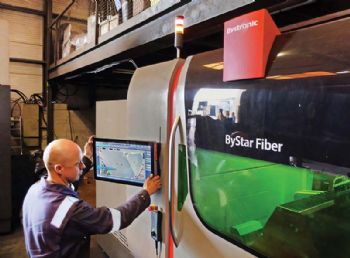
Norfolk-based Eastern Attachments manufactures construction and agricultural attachments, supplying companies such as Persimmon Homes, Taylor Wimpey and JCB. It has not only survived in a competitive market but become a market leader in its fields of operation.
This has only been possible by using technologically advanced and efficient production equipment, such as a Bystronic 10kW fibre laser cutting machine with automation to profile components out of mild-steel sheet, plus seven Fanuc robotic welding cells powered by the latest Fronius pulse weld sets to fabricate the products.
Eastern Attachments director Daniel Leslie, one of four brothers who started the firm in 1996, said: “The UK is known for its strength in high-added-value engineering, such as aerospace, but there is a perception that we cannot compete with low-wage countries in Eastern Europe and the Far East when it comes to manufacturing relatively low-value simple items.
“In 2007, most handling buckets for construction and agricultural equipment in the UK came from overseas; these days, imports are becoming a rarity. Within six months of entering these sectors, we had taken half the market for the products we manufacture — buckets, handling grabs, fork-lift attachments and tipping skips — and we now produce the vast majority of units sold in the UK.”

Highlighting how Eastern Europe has been able to succeed so dramatically, co-director Philip Leslie said: “It comes down to constant innovation and a relentless pursuit of improvement, as demonstrated by our use of high-strength steels from SSAB — Swedish Steel — back in 2002.
“This steel manufacturer continues to invest in the development of new materials, which will soon see even better steels with a strength-to-weight equivalent to that of titanium and higher than that of aircraft aluminium.”
Using these materials allows attachments to be made considerably lighter, so a construction firm or farmer can lift more material to achieve higher productivity — or downsize a machine to reduce capital expenditure.
A spin-off advantage of these high-strength steels is fewer impurities (such as silicon); this is beneficial for achieving better edge quality when laser cutting, especially with materials that are 12mm thick or less when using nitrogen rather than oxygen as the cutting gas.
The company’s comprehensive penetration of the attachments sector has resulted in average annual growth of 15% for the last decade, but 2017 has been a bumper year, with an increase in turnover so far of over 30%.
Keeping pace with such a sharp upturn in demand was a problem — particularly in the sheet preparation department, where two high-definition CNC plasma cutters were struggling to meet the required output.
Fibre technology
The directors had foreseen this situation and recognised three years ago that laser profiling was the way to go. They were waiting for fibre laser cutting to mature, having dismissed the CO2 laser as ‘yesterday’s technology’.
When Bystronic launched the first-ever 10kW fibre laser machine at the end of 2016 — capable of cutting mild steel up to 25mm thick — they decided it was time to act.
Three other potential fibre laser machine suppliers were considered before the ByStar Fiber 3015 was purchased from Coventry-based Bystronic UK Ltd (
www.bystronic.com).
Eastern Attachments was already aware of Bystronic and the effectiveness of the company’s service department, having used its shearing and press braking machines for several years.
Prompt service to maintain high up-time of the ByStar Fiber 3015 is crucial, as it produces nearly all attachment components in the Norfolk facility (the one remaining plasma machine is used for cutting a small amount of material up to 40mm thick).
The 3 x 1.5m-capacity fibre laser cutter, equipped with a ByTrans Cross for sheet storage and automated material handling (to and from the machine), was installed at the beginning of summer 2017, just in time to prevent the need for a second shift on the two manually loaded plasma cutters.
The scale of the difficulty Eastern Attachments was facing can be gauged from the fact that its current factory was built to manufacture 900 units per month; in September this year, more than 2,000 units were produced.
Achieving more than double the originally planned output was only possible due to the automation supplied with the fibre laser cutter.
Daniel Leslie estimates that the cell, which runs ‘round the clock’ (with 8hr of operator attendance), can typically produce as much in 24hr as a manually loaded plasma machine produces in five 8hr day shifts.

That said, when processing mild steel that is 5mm thick or less, the productivity improvement is much higher. The sheer speed of fibre laser cutting means that what would take 8hr on a plasma cutter can be achieved in 1hr by the fibre laser cell.
Even on thicker gauges, where the laser cutting speed is broadly similar to that of a plasma machine, the Bystronic saves time through faster rapid traverse from pierce to pierce and automated loading and unloading of sheet in under 1min, compared with 20min manual load/unload on a non-automated machine.
In conclusion, Daniel Leslie said: “The Bystronic laser has allowed us to increase cut-part production dramatically in a small footprint, at the same time raising dimensional accuracy and edge quality. Fabrication is easier, the end products are improved, and re-work has been eliminated.
“We are about to build a new factory nearby that will be four-times the size of our existing facility; we will be moving within two years.
“The new building will allow us to expand even faster into new markets, grow our exports and prevent us from turning away work through lack of production capacity.”